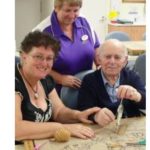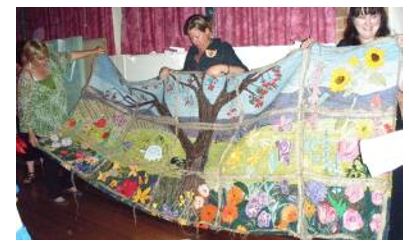
Norma Hatchett has been teaching rug hooking for almost 30 years to children in after-school classes, disabled and blind and recently to residents of aged care facilities, using a special mechanical “speed needle” (Rumplestiltskin). Norma discovered rug hooking in 1989 when she was looking for therapy for her 8-year old son who had suffered a stroke. This lead to her rug hooking business called “Hooked on Hessian”. Norma’s story “The healing Side of Hooking” was published in Rug Hooking Magazine Sep/Oct 2012.
The following was taken from an article in the Australian Rugmakers Guild Newsletter Oct/Nov/Dec 2013 – you can see the full article and more images of her work here.
Here Norma demonstrates the mechanical hook, working from the back of the design stretched tightly over a frame on a flat surface, and the Rumplestiltskin tool on a rug designed and hooked by one of her after-school students.
In 2006 Norma was introduced to the Community Arts Network WA and received funding for a program to work with residents of an aged care facility where under Norma’s direction and with the help of volunteers, a 9’ x 4’ tapestry “Cherished Memories, Childhood Dreams” was created by the residents.
This program was successful and in 2008 a similar program was undertaken at another Aged Care Hostel, where a 7’ x 4’ tapestry “Family” was completed by the residents. A resounding success it was followed by another session in 2010 when over a period of 12 weeks the residents completed “A Garden for Everyone” (9’ x 4’)
Norma’s ability to listen and coax memories from those who have such a battle to remember is inspiring, and her energy is boundless. She takes the memories and translates them into a design for the overall tapestry. Norma said that “family” and childhood surroundings seem to be most important to people struggling with this problem. Once the overall design is established Norma marks it out in segments which are enlarged to fit on her special frames. This is where they stay until completion. The residents are given a section of the tapestry to work on, depending on their ability and throughout the hooking process each is assisted by a volunteer who helps decide on colours, cut wool and thread the hook, sometimes guiding the residents hand through the process. Where possible the choice of colour is left up to the resident. At the end of each days session Norma casts an eye over all the pieces to make sure there is continuity of colour and in some cases does a little “remedial” hooking. At the end of the sessions, usually 12-14 weeks, Norma has the mammoth task of stitching the sections together and creating the wonderful tapestries that are hung in the public areas of the aged care facility for the residents and their families to relate to and enjoy. In 2013 I visited Norma as she was working on yet another of these projects, assisted by students from a nearby High School. It was an absolute eye-opener to see the success of this inter-generational, multi-cultural endeavour. Permission was given by the facility to publish images taken.



